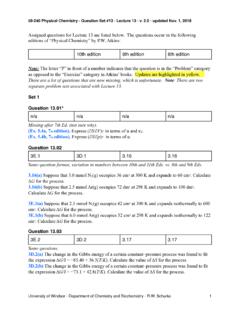Transcription of 59-240 Physical Chemistry - Question Set #10 - Lecture 10 ...
1 59-240 Physical Chemistry - Question Set #10 - Lecture 10 - v. - updated Oct. 14, 2018 Assigned questions for Lecture 10 are listed below (there are two sets). The questions occur in the following editions of Physical Chemistry by Atkins:Note: The letter P in front of a number indicates that the Question is in the Problem category as opposed to the Exercise category in Atkins books. Updates are highlighted in yellow. There are a fair number of differences and missing questions, and unfortunately, a lot of good problems were removed years ago from earlier editions. Set 1 Question variation: 11th and 10th Eds. (bottom) vs. 8th and 9th Eds. (top) (a) Calculate the change in entropy when 25 kJ of energy is transferred reversibly and isothermally as heat to a large block of iron at (a) 0 C, (b) 100 C.
2 (b) Calculate the change in entropy when 50 kJ of energy is transferred reversibly and isothermally as heat to a large block of copper at (a) 0 C, (b) 70 C. (a) Calculate the change in entropy when 100 kJ of energy is transferred reversibly and isothermally as heat to a large block of copper at (i) 0 C, (ii) 50 C. (b) Calculate the change in entropy when 250 kJ of energy is transferred reversibly and isothermally as heat to a large block of lead at (i) 20 C, (ii) 100 Ed. (a) Calculate the molar entropy of a constant-volume sample of neon at 500 K given that it is J K-1 mol-1 at 298 K. (b) Calculate the molar entropy of a constant-volume sample of argon at 250 K given that it is J K-1 mol-1 at 298 in 11th Ed. (a) The molar entropy of a sample of neon is J K-1 mol-1 at 298 K.
3 The sample is heated at constant volume to 500 K; assuming that the molar constant-volume heat capacity of neon is (3/2)R, calculate the molar entropy of the sample. (a) Calculate the molar entropy of a constant-volume sample of argon at 250 K given that it is J K-1 mol-1 at 298 K; the molar constant-volume heat capacity of argon is (3/2) edition10th edition9th edition8th of Windsor - department of Chemistry and Biochemistry - Schurko 159-240 Physical Chemistry - Question Set #10 - Lecture 10 - v. - updated Oct. 14, 2018 Question (a) Calculate S (for the system) when the state of mol of perfect gas atoms, for which Cp,m = (5/2)R, is changed from 25 C and atm to 125 C and atm. How do you rationalize the sign of S? (b) Calculate S (for the system) when the state of mol diatomic perfect gas molecules, for which Cp,m = (7/2)R, is changed from 25 C and atm to 135 C and atm.
4 How do you rationalize the sign of S? Question Question is missing from 10th and 11th (a) A sample consisting of mol of diatomic perfect gas molecules at 200 K is compressed reversibly and adiabatically until its temperature reaches 250 K. Given that CV,m = J K-1 mol-1, calculate q, w, U, H, and S. (b) A sample consisting of mol of diatomic perfect gas molecules at 250 K is compressed reversibly and adiabatically until its temperature reaches 300 K. Given that CV,m = J K-1 mol-1, calculate q, w, U, H, and 2 Question variations: 11th and 10th Eds. (bottom) vs. 8th and 9th Eds. (top). (a) Calculate H and Stot when two copper blocks, each of mass kg, one at 100 C and the other at 0 C, are placed in contact in an isolated container. The specific heat capacity of copper is J K-1 g-1 and may be assumed constant over the temperature range involved.
5 (b) Calculate H and Stot when two iron blocks, each of mass kg, one at 200 C and the other at 25 C, are placed in contact in an isolated container. The specific heat capacity of iron is J K-1 g-1 and may be assumed constant over the temperature range (a) Calculate Stot when two copper blocks, each of mass kg, one at 50 C and the other at 0 C are placed in contact in an isolated container. The specific heat capacity of copper is J K 1 g 1 and may be assumed constant over the temperature range involved. (b) Calculate Stot when two iron blocks, each of mass kg, one at 100 C and the other at 25 C, are placed in contact in an isolated container. The specific heat capacity of iron is J K 1 g 1 and may be assumed constant over the temperature range of Windsor - department of Chemistry and Biochemistry - Schurko 259-240 Physical Chemistry - Question Set #10 - Lecture 10 - v.
6 - updated Oct. 14, 2018 Question from 8th and later editions (not sure why). Ex. , 7th edition. Calculate the increase in entropy when mol of a monatomic perfect gas with Cp,m = (5/2)R is heated from 300 K to 600 K and simultaneously expanded from L to L. Ex. , 7th edition. Calculate the increase in entropy when mol of a monatomic perfect gas with Cp,m = (5/2)R is heated from 250 K to 700 K and simultaneously expanded from L to Missing from 8th and later editions (not sure why). Ex. , 7th edition. A system undergoes a process in which the entropy change is + J K-1. During the process, kJ of heat is added to the system at 500 K. Is the process thermodynamically reversible? Explain your reasoning. Ex. , 7th edition. A system undergoes a process in which the entropy change is + J K-1.
7 During the process, kJ of heat is added to the system at 350 K. Is the process thermodynamically reversible? Explain your from 8th and later editions (not sure why). Ex. , 7th edition. A sample of aluminum of mass kg is cooled at constant pressure from 300 K to 265 K. Calculate (a) the energy that must be removed as heat and (b) the change in the entropy of the sample. Ex. , 7th edition. A sample of copper of mass kg is cooled at constant pressure from 330 K to 275 K. Calculate (a) the energy that must be removed as heat and (b) the change in the entropy of the from 8th and later editions (not sure why). Ex. , 7th edition. A sample of methane gas of mass 25 g at 250 K and atm expands isothermally until the pressure is atm. Calculate the change in entropy of the gas.
8 Ex. , 7th edition. A sample of nitrogen gas of mass 35 g at 230 K and atm expands isothermally until the pressure is atm. Calculate the change in entropy of the gas. n/an/an/an/an/an/an/an/an/an/an/an/an/an /an/an/aUniversity of Windsor - department of Chemistry and Biochemistry - Schurko 359-240 Physical Chemistry - Question Set #10 - Lecture 10 - v. - updated Oct. 14, 2018 Question Ex. , 7th edition. A sample of perfect gas that initially occupies L at 250 K and atm is compressed isothermally. To what volume must the gas be compressed to reduce its entropy by J K-1? Ex. , 7th edition. A sample of perfect gas that initially occupies L at 270 K and atm is compressed isothermally. To what volume must the gas be compressed to reduce its entropy by J K-1?
9 Answer Question is missing from 10th Ed. n/an/an/an/an/ of Windsor - department of Chemistry and Biochemistry - Schurko 459-240 Physical Chemistry - Question Set #10 - Lecture 10 - v. - updated Oct. 14, 2018 Answer from 8th and later editions (not sure why). n/an/an/an/aUniversity of Windsor - department of Chemistry and Biochemistry - Schurko 559-240 Physical Chemistry - Question Set #10 - Lecture 10 - v. - updated Oct. 14, 2018 Answer Missing from 8th and later editions (not sure why). n/an/an/an/aUniversity of Windsor - department of Chemistry and Biochemistry - Schurko 659-240 Physical Chemistry - Question Set #10 - Lecture 10 - v. - updated Oct. 14, 2018 Answer from 8th and later editions (not sure why). n/an/an/an/aUniversity of Windsor - department of Chemistry and Biochemistry - Schurko 759-240 Physical Chemistry - Question Set #10 - Lecture 10 - v.
10 - updated Oct. 14, 2018 Answer from 8th and later editions (not sure why). Answer from 8th and later editions (not sure why). n/an/an/an/an/an/an/an/aUniversity of Windsor - department of Chemistry and Biochemistry - Schurko 8



